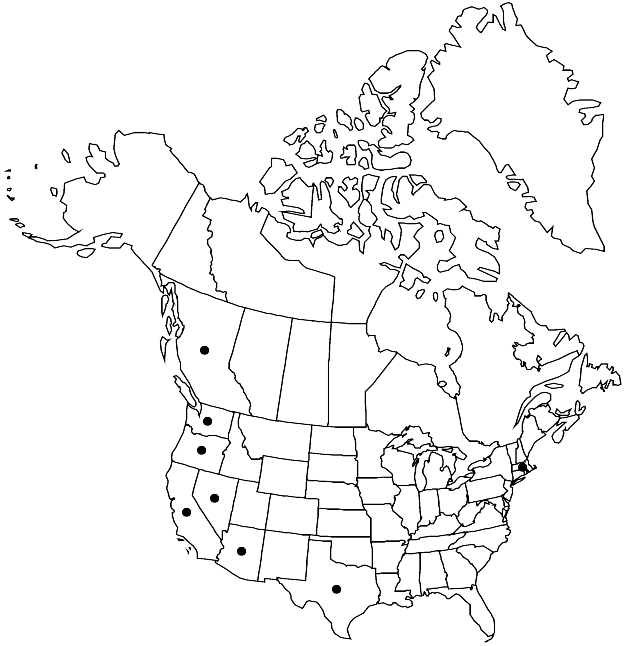Difference between revisions of "Sisymbrium orientale"
Cent. Pl. II, 24. 1756.
FNA>Volume Importer |
imported>Volume Importer |
||
| Line 6: | Line 6: | ||
|place=24. 1756 | |place=24. 1756 | ||
|year=1756 | |year=1756 | ||
| + | }} | ||
| + | |special_status={{Treatment/ID/Special_status | ||
| + | |code=W | ||
| + | |label=Weedy | ||
| + | }}{{Treatment/ID/Special_status | ||
| + | |code=I | ||
| + | |label=Introduced | ||
}} | }} | ||
|basionyms= | |basionyms= | ||
| Line 23: | Line 30: | ||
|elevation=0-1300 m | |elevation=0-1300 m | ||
|distribution=B.C.;Ariz.;Calif.;Mass.;Nev.;Oreg.;Tex.;Wash.;Europe;sw Asia;n Africa;introduced also in Central America;South America;Australia. | |distribution=B.C.;Ariz.;Calif.;Mass.;Nev.;Oreg.;Tex.;Wash.;Europe;sw Asia;n Africa;introduced also in Central America;South America;Australia. | ||
| + | |introduced=true | ||
|tables= | |tables= | ||
|references= | |references= | ||
| Line 45: | Line 53: | ||
|publication title=Cent. Pl. II, | |publication title=Cent. Pl. II, | ||
|publication year=1756 | |publication year=1756 | ||
| − | |special status= | + | |special status=Weedy;Introduced |
| − | |source xml=https:// | + | |source xml=https://bibilujan@bitbucket.org/aafc-mbb/fna-data-curation.git/src/bb6b7e3a7de7d3b7888a1ad48c7fd8f5c722d8d6/coarse_grained_fna_xml/V7/V7_1149.xml |
|tribe=Brassicaceae tribe Sisymbrieae | |tribe=Brassicaceae tribe Sisymbrieae | ||
|genus=Sisymbrium | |genus=Sisymbrium | ||
Revision as of 00:52, 28 May 2020
Annuals; glabrous or pubescent. Stems erect, branched distally, (1–)2–7(–8.5) dm, sparsely to densely (soft) pubescent at least basally, usually glabrous distally. Basal leaves rosulate; petiole (1–)2–5(–9) cm; blade broadly oblanceolate to oblong-oblanceolate (in outline), 3–8(–10) cm × (10–)20–40(–60) mm, margins runcinate-pinnatipartite; lobes 2–5 on each side, oblong or lanceolate, much smaller than terminal lobe, margins subentire or dentate, (terminal lobe lanceolate, deltate, or often hastate). Cauline leaves similar to basal; (distalmost) blade with 1 or 2 lobes on each side, much smaller than terminal lobe, (terminal lobe narrowly lanceolate, linear, or hastate). Fruiting pedicels ascending to subdivaricate, stout, nearly as wide as fruit, 3–6 mm. Flowers: sepals ascending, oblong, 3.5–5.5 × 1–2 mm; petals spatulate, (6–)7–9(–10) × 2.5–4 mm, claw 3–5.5 mm; filaments (4–)5–8 mm; anthers oblong, 1–1.8 mm. Fruits narrowly linear, straight, smooth, stout, (5–)6–10(–13) cm × 1–1.5 mm; valves glabrous or pubescent; ovules (60–)80–100(–140) per ovary; style (subclavate), 1–3(–4) mm; stigma prominently 2-lobed. Seeds 1–1.5 × 0.7–0.9 mm. 2n = 14.
Phenology: Flowering Mar-early Jun.
Habitat: Waste grounds, roadsides, disturbed sites
Elevation: 0-1300 m
Distribution

Introduced; B.C., Ariz., Calif., Mass., Nev., Oreg., Tex., Wash., Europe, sw Asia, n Africa, introduced also in Central America, South America, Australia.
Discussion
Selected References
None.